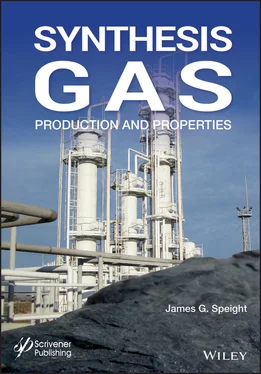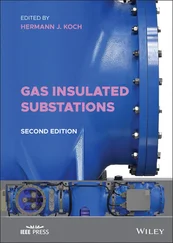Library of Congress Cataloging-in-Publication Data
ISBN 978-1-119-70772-1
Cover image: Oil Refinery - Fotogigi85, Coal Image - Photographer | Dreamstime.comCover design by Kris Hackerott
The projections for the continued use of fossil fuels indicate that there will be at least another five decades of fossil fuel use (especially coal and petroleum) before biomass and other forms of alternate energy take hold. Furthermore, estimations that the era of fossil fuels (petroleum, coal, and natural gas) will be almost over when the cumulative production of the fossil resources reaches 85% of their initial total reserves may or may not have some merit. In fact, the relative scarcity (compared to a few decades ago) of petroleum was real but it seems that the remaining reserves make it likely that there will be an adequate supply of energy for several decades. The environmental issues are very real and require serious and continuous attention.
In preparation for the depletion of fossil fuel resources, gasification can be proposed as a viable and reliable alternative solution for energy recovery from a variety of feedstocks. Gasification processes can accept a variety of feedstocks but the reactor must be selected on the basis of the feedstock properties and behavior in the process, especially when coal, biomass, and various wastes are considered as gasification feedstocks. The focus will be on the production of synthesis gas as an intermediate in the production of the necessary fuels and chemicals.
On the other hand, the gasification process still faces some technical and economic problems, mainly related to the highly heterogeneous nature of unconventional feedstocks such as biomass and municipal solid wastes and the relatively limited number of gasification plants worldwide based on this technology that have continuous operating experience under commercial conditions.
Synthesis gas (syngas) is a fuel gas mixture consisting predominantly of carbon monoxide and hydrogen and is typically a product of a gasification. The gasification process is applicable to many carbonaceous feedstocks including natural gas, petroleum resids, coal, biomass, by reaction of the feedstock with steam (steam reforming), carbon dioxide (dry reforming) or oxygen (partial oxidation). Synthesis gas is a crucial intermediate resource for production of hydrogen, ammonia, methanol, and synthetic hydrocarbon fuels.
It is the purpose of this book to present an overview of the issues related to the production and use of synthesis gas and to present to the reader the means by which the continually evolving synthesis gas technology will play a role in future production of fuels and chemicals.
Dr. James G. SpeightLaramie, Wyoming, USA
Part 1 PRODUCTION
1 Energy Sources and Energy Supply
1.1 Introduction
The major sources of energy have been, and continue to be, the various fossil fuels of which the major component of the group are (i) natural gas, (ii) crude oil, and (iii) coal with tar sand bitumen and oil shale available in considerable quantities for use on an as-needed basis. However, the Earth contains a finite supply of fossil fuels – although there are questions about the real amounts of these fossil fuels remaining. The best current estimates for the longevity of each fossil fuel is estimated from the reserves/production ratio (BP, 2019) which gives an indication (in years) of how long each fossil fuel will last at the current rates of production. Thus, estimates vary from at least 50 years of crude oil at current rates of consumption to 300 years of coal at current rates of consumption with natural gas varying between the two extremes. In addition, the amounts of natural gas and crude oil located in tight sandstone formations and in shale formations has added a recent but exciting twist to the amount of these fossil fuels remaining. Peak energy theory proponents are inclined to discount the tight formations and shale formation as a mere aberration (or a hiccup) in the depletion of these resources while opponents of the peak energy theory take the opposite view and consider tight formations and shale formations as prolonging the longevity of natural gas and crude oil by a substantial time period. In addition, some areas of the Earth are still relatively unexplored or have been poorly analyzed and (using crude oil as the example) knowledge of in-ground resources increases dramatically as an oil reservoir is exploited.
Energy sources have been used since the beginning of recorded history and the fossil fuel resources will continue to be recognized as major sources of energy for at least the foreseeable future (Crane et al. , 2010; World Energy Council, 2008; Gudmestad et al. , 2010; Speight, 2011a, 2011b, Khoshnaw, 2013; Speight, 2014a; BP, 2019). Fossil fuels are those fuels, namely natural gas, crude oil (including heavy crude oil), extra heavy crude oil, tar sand bitumen, coal, and oil shale produced by the decay of plant remains over geological time represent an unrealized potential, with liquid fuels from crude oil being only a fraction of those that could ultimately be produced from heavy oil and tar sand bitumen (Speight, 1990, 1997, 2011a; 2013d, 2013e, 2014).
In fact, at the present time, the majority of the energy consumed worldwide is produced from the fossil fuels (crude oil: approximately 38 to 40%, coal: approximately 31 to 35%, natural gas: approximately 20 to 25%) with the remainder of the energy requirements to come from nuclear and hydroelectric sources. As a result, fossil fuels (in varying amounts depending upon the source of information) are projected to be the major sources of energy for the next 50 years (Crane et al. , 2010; World Energy Council, 2008; Gudmestad et al. , 2010; Speight, 2011a, 2011b, Khoshnaw, 2013; BP, 2014; Speight, 2014; BP, 2019).
Fuels from fossil fuels (especially the crude oil-based fuels) are well-established products that have served industry and domestic consumers for more than 100 years and for the foreseeable future various fuels will still be largely based on hydrocarbon fuels derived from crude oil. Although the theory of peak oil is questionable, there is no doubt that crude oil, once considered inexhaustible, is being depleted at a measurable rate. The supposition by peak oil proponents is that supplies of crude oil are approaching a precipice in which fuels that are currently available may, within a foreseeable short time frame, be no longer available. While such a scenario is considered to be unlikely (Speight and Islam, 2016), the need to consider alternate technologies to produce liquid fuels that could mitigate the forthcoming effects of the shortage of transportation fuels is necessary and cannot be ignored.
The best current estimates for the longevity of each fossil fuel is estimated from the reserves/production ratio (BP, 2019) which gives an indication (in years) of how long each fossil fuel will last at the current rates of production.
Alternate fuels produced from a source other than crude oil are making some headway into the fuel demand. For example, diesel from plant sources (biodiesel) is similar in performance to diesel from crude oil and has the added advantage of a higher cetane rating than crude oil-derived diesel. However, the production of liquid fuels from sources other than crude oil has a checkered history. The on-again-off-again efforts that are the result of the inability of the political decision-makers to formulate meaningful policies has caused the production of non-conventional fuels to move slowly, if at all (Yergin, 1991; Bower, 2009; Wihbey, 2009; Speight, 2011a, 2011b, Yergin, 2011; Speight, 2014a).
This is due in no small part to the price fluctuations of crude oil and the common fuel products (i.e., gasoline and diesel fuel) and the lack of planning and associated foresight by various levels of government. It must be realized that for decades the price of crude oil produced in the crude oil-exporting nations has always been maintained at a level that was sufficiently low to discourage the establishment of a domestic synthetic fuels industry in many of the crude oil-consuming countries (Speight, 2011a). However, in spite of additional supplies of crude oil and natural gas coming from tight formations and shale formation, the time will come when the lack of preparedness for the production of non-conventional fuels may set many a national government on its heels. It is not a matter of “if the lack of preparedness come to fruition” but “when will the lack of preparedness come to fruition?”
Читать дальше












